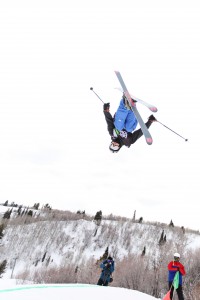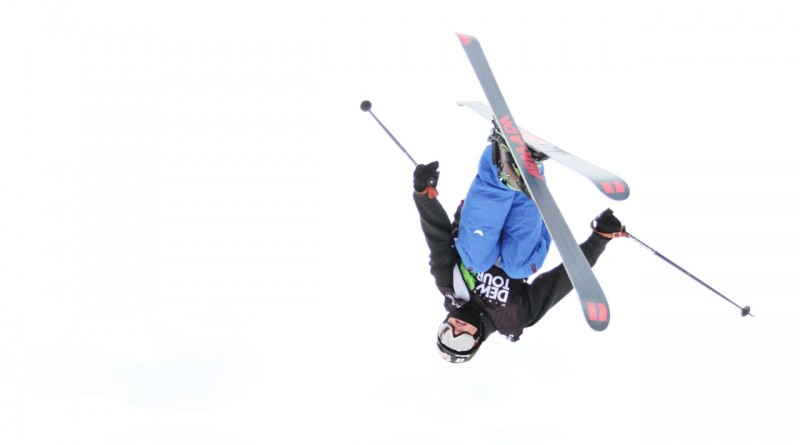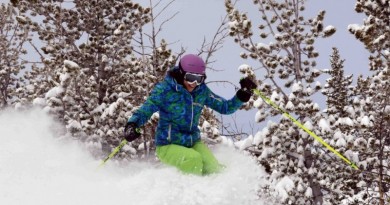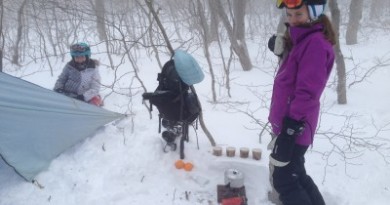Coach Keene: 5 Ways to Deal with Fear
You are standing at the top of the gnarliest run that you’ve ever thought of attempting.
It could be your first blue square or a double black diamond, or a woods line that you have aspired to. Maybe a virgin voyage in the halfpipe or a trip off a bigger jump. Perhaps it’s your first try at a new trick—whatever. What matters is that it represents a big step up for you. And you’re scared.
You’ve never been here before. You think often about pushing yourself. But now that it’s right in front of your face you’re not so sure. It seemed like a good idea while après-ing with friends yesterday by a warm fire, and then again this morning while driving to the mountain fueled by a strong cup of coffee. But now that you’re actually face-to-face with the challenge the questions creep in: “Is this what I really want?” “Do I absolutely have to do this”? “Am I really ready?”
Right now you have two choices: To follow through with your plan, or to bail. And you know exactly where each road leads. It’s a choice between glory (or some measure of it), and guaranteed safety. The lion inside you wants to roar and just dive in, but the chicken within you isn’t so sure. You stand there for far too long and grow cold, looking on helplessly as your confidence drains, blown away by the icy wind.
Finally, you scuttle off with your tail between your legs toward a run you’ve done a thousand times, which you predictably rip, but that doesn’t make you feel any better. In fact, it makes you feel worse.
It didn’t have to be like this.
Overcoming fear is a skill like any other, and one that can be improved upon. It is the most obvious ability that distinguishes us from our sports heroes. But contrary to what we might think, it doesn’t come naturally to them either. By looking at the way great athletes digest and deal with fear we can acquire new tools; tricks that will allow us to step outside of our self-imposed boundaries and to do so with a margin for safety and self-confidence.
Do Shaun White and Gus Kenworthy get scared? As their coach, I’ve spent countless hours working with them to try new tricks and you bet they do. Though two of the greatest action-sports athletes of all time, their enjoyment of sport comes in part from taking that next step—pushing themselves. True, they are typically jumping from 11 to 12 on the volume knob, and you are probably looking to nudge things up from about a two to a three. But the relative magnitude of the step is exactly the same, and they feel the same fear as you and I do.

Shaun and Gus, and pros in general, have a list of tricks that allow them to overcome their fear and to take the next step. Here are five of the most common:
- Get Prepared
Like you, these guys don’t dream that they can do something far above their level and then just go for it the next day. That’s a good way to get hurt. Instead, they work themselves into a position where that next thing is just about ready to happen. For example, before Shaun did his first 1080 he probably did three hundred 900s. Through practice he reached a point where he became bored with 900s, and found himself stopping the trick at 900 degrees of rotation instead of letting it go on to 1080. Then, when the conditions were perfect, he took the 900 to a 1080—another half rotation.
Prepare yourself for any challenge by practicing all of the skills you’ll need to succeed. Then, when you’re standing at the top getting ready to drop-in, take stock of everything you have done to get ready for this moment. This will remind you that you really are ready for this.
- Choose The Perfect Situation
Is the best time to try something new and challenging when you’re alone, it’s cloudy, 30 below zero, icy, and 3:30 pm? Or would it be smarter to push yourself when temps are mild, it’s sunny out with great visibility, you’re looking at a perfect slope or feature and you’re with friends you like and who support you? The answer should be pretty obvious.
For years, Gus Kenworthy has worked on his skiing, learning more and more difficult tricks along the way. Now he certainly knows when to pull the trigger on something new, and when not to. We were together at a camp out West a couple of years ago where we had a private 80-foot jump, a sled to give Gus lots of laps and perfect weather. Gus knew he had that perfect situation and he took advantage of it, learning four new tricks that had been on his mind for a while. Three of those were firsts in the world of freeskiing, and he used two of them to win the 2014 Olympic silver medal in Sochi.

- Embrace The Butterflies
To most people, the queasy feeling that they get in their gut before dropping into something new is interpreted as a bad thing. That couldn’t be further from the truth! Here’s the reality, and what I tell my athletes:
The butterflies are adrenaline pouring into your system that prepares you for what you are about to do. Adrenaline is a powerful natural stimulant that, once released into your system makes you stronger, quicker and more capable. Your body is making sure that you have the best chance for success.
The next time that you are challenging yourself and feel those familiar butterflies, embrace them. Say to yourself; “Yeah, I’ve got my butterflies, and I’m ready!” Trust me, if you step up to a challenge and don’t have butterflies, something’s wrong.
- Get The First Try Out Of The Way
Often when trying something new both experts and amateurs will falter on the first try. The difference? Typically the first words out of the pro’s mouth will be “OK, glad I got that one out of the way.” What pros mean is that they have now come face-to-face with the challenge and understand it far more than they did before. They may have failed on the first try, but the mystery—and a lot of the fear associated with it—has been removed. They now know exactly what to do. The second time they usually nail it.
- Have A Motivating Song
During the period of my life when I was doing first ascents and steep first descents on my snowboard, I had a song that played in my head (no iPhone or earbuds back then) and that got me through the most challenging moments. It was the Allman Brothers’ “You Can’t Take It With You.” In it Greg Allman wailed over and over “You can’t take it with you when you go!” A fatalistic message, yes, but one that cleared my eyes and mind and made me think to myself, “OK, Bud, this is it. Freeze up and fail and you’ll get hurt or die. Loosen up and focus, and you succeed!”
It worked every time.
It doesn’t have to be a fall-or-die situation for this to work. It is well accepted that music has the ability to relax us and enhance performance. Stack the deck in your favor. Find your own song that elicits the same attitude and response, and then press “play.”
I want to make one thing very clear: Control your fears, don’t try to eliminate them. Though unchecked fear can be paralyzing, you should always have a healthy respect for the challenge. Fear has the positive effect of putting you on edge. Being on edge makes sure that you are awake and sharp, just like you want to be. Trust me, it’s not only ok to be scared, it’s a good thing.
Coaching Coaches

5 Phrases That Help
“You’ve got this.”
“Trust yourself.”
“You’ve visualized it, now do it.”
‘Take a few deep breaths and relax, then go when you’re feeling it.”
“You’ve done all of the preparation and you know you’re ready, now believe in yourself.”
4 Things You Should Never Say
“I do this all the time, it’s no big deal.”
“Stop being a p#$$Y and just do it!”
“What are you waiting for, just go!”
“Come on, you can do this!”**
**Though even experienced coaches say “You can do this,” it is a phrase that I avoid for a simple reason: It implies that you “can” do this, not that you will. I don’t like those odds, and I don’t want to put the idea that things “might” work out into the head of whomever I am trying to help. I want to be more positive, and certain, of their success.



